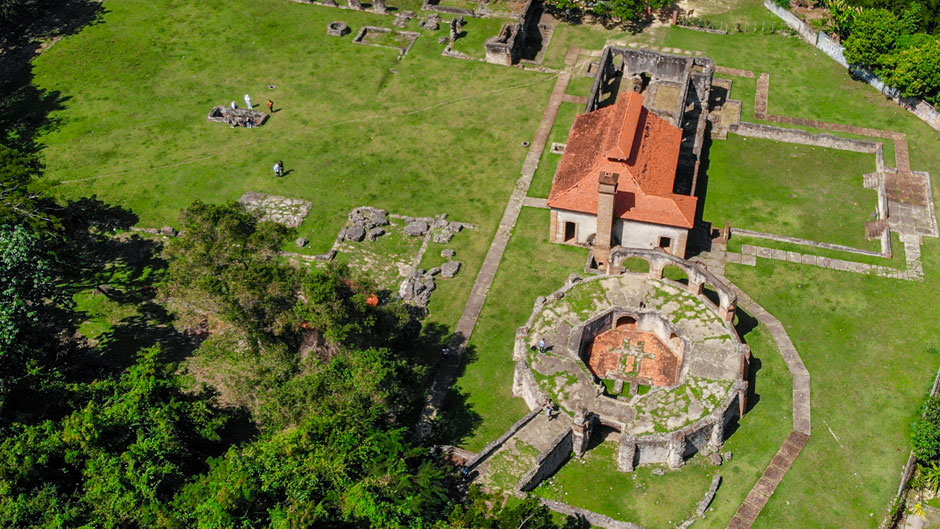They are the vestiges of a sad period in Caribbean history. Elegant Spanish-style buildings, with stately concrete columns and arches, which served as sugar mills where hundreds of African slaves toiled to harvest “white gold,” or sugar.
The Dominican Republic has many such abandoned mills, near small towns and rivers. In mid-February, 16 University of Miami School of Architecture students and professors joined a group of students from the Universidad Nacional Pedro Henriquez Ureña (UNPHU) to tour four of these mills, to begin a project to refurbish these structures and open them for new public use.
The idea for the project stemmed from previous work done in the island by associate professor of practice Carmen Guerrero, who led the Upper Level Studio trip along with Jaime Correa, also an associate professor of practice at School of Architecture. The trip was sponsored by the Canin Award, an annual gift from Myrna and Brian Canin, founders of Canin Associates in Orlando. They have been sponsors for the past 15 years.
“As the child of Dominican parents who spent summers and holidays there, I had no idea that we had these historic sugar mills,” said Guerrero. “Now the government wants to refurbish them so that they can become usable for tourism and other uses.”
Many other countries in the Caribbean have rebuilt their sugar mills into luxurious hotels or cultural centers, which attract the public and generate revenue. Santo Domingo, the first founded city in the New World and a stronghold for the Spanish Conquistadores’ prodigious sugar industry, has yet to refurbish these mills. The four visited by the architecture students during the three-day trip were Boca de Nigua, Palave, Diego Caballero and Engombe.
“This project and trip exposed the students to the culture of the island as well as the socio-political history of the Dominican Republic and how that has translated into its rural and urban areas,” said Correa.
Indeed, the UM students joined by their cohorts from the island as well as a historian and archeologist, toured the ruins and watched how the area residents interacted with the structures. The Dominican students are also working on design projects for the mills.
“It was a beautiful dynamic to watch as the students worked together,” said Jose Constanza, UNPHU dean of student welfare and professor of architecture, whose students are also developing projects to renovate the mills. “There was very little language barrier because they used the universal language of drawing to communicate.”
Constanza added that having UM students working on this project added a “global perspective” that could be beneficial. “People from other places can have a different way of thinking and can even be risqué in their approach,” he said.
At the Engombe site, one of the largest in the country which still houses a two-story mansion, a chapel, a warehouse structure and a mill used to extract juice from the sugar cane called a trapiche, locals use the grounds for picnics, as a playground, and even as a backdrop for wedding pictures.
For UM architecture students Emily Suarez and Andrea Hernandez, the only way to portray the history of Engombe in their design was to be true to its roots.
“We did not want to intervene with the structures’ integrity,” said Suarez, a fifth-year architecture student. “So instead we decided to envelop the structure with black material but leave the ruins as they are.”
The black material symbolizes the sad history of slavery, which was such an integral part of sugar plantation lives, said Suarez. “We have to acknowledge the sad part of the story.”
In their design, Suarez and Hernandez also added a white tower with 16 telescopes. The telescopes would provide an overlook for visitors who come to admire the surrounding countryside, but it would also hark back to the 16th century practice by plantation overseers of watching over the slaves as they carried on their backbreaking work of cutting and harvesting sugar cane.
For Max Erickson and Olivia Kramer, fifth-year architecture students who did not speak Spanish, the language barrier did not detain them from absorbing the history and culture of the Dominican countryside. Dominican students helped them out by translating lessons on the history of the island and the Colonial Period.
“I was so impressed by the topography of the place and how green it was,” said Erickson. “As we learned about the ruins we realized that we needed to address the needs of the people who live near there.”
In their designs of Engombe, Erickson and Kramer featured several elements that would provide teaching moments for visitors. One of them was adding an elevated walkway that would link all the structures and would feature plaques describing various segments of the sugar production industry at the time.
Their design also showed the abandoned warehouse as a completely remodeled space to be used for parties, family reunions or community gatherings. Parts of the large space could also work as a library and café, they said.
On Monday, April 29, a delegation of faculty from Santo Domingo’s UNPHU will visit UM’s School of Architecture to review all the proposed projects the students have worked on.

